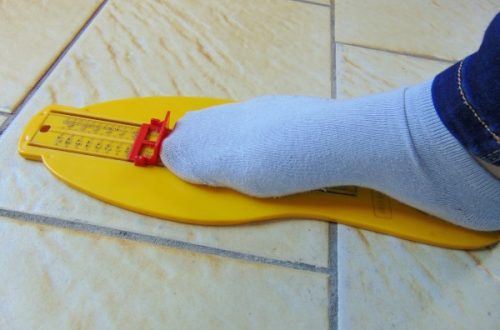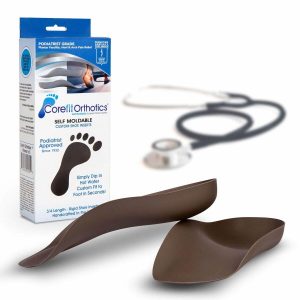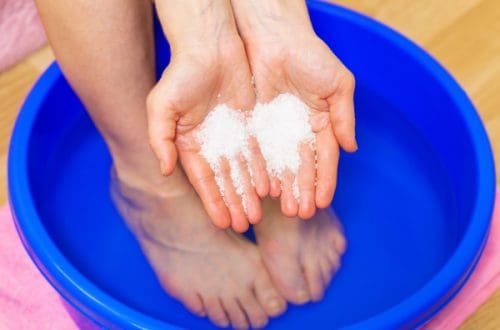Approximately 1 in 10 people will develop plantar fasciitis at some time during their lifetime. As we get older, the likelyhood of getting the condition increases.
So why is age a factor with plantar fasciitis? The most common age for developing plantar fasciitis is 40 – 60 years old. As we age, the plantar fascia becomes weaker, and the fatty heel pad that protects the bones of the foot becomes thinner. This leads to increased risks of developing foot pain, and associated ailments such as plantar fasciitis.
We will now look deeper into the reasons for age related plantar fasciitis being so common, and what you can do to reduce the risks of suffering with the condition.
Age Related Plantar Fasciitis
Plantar Fasciitis can affect anyone, at any age, depending on their lifestyle, however age related plantar fasciitis is more common in 40 – 60 year olds.
As you can imagine, after about 40 – 50 years of carrying the weight of your body around, the feet are going to become tired and vulnerable to some kind of foot problems.
Depending on how you have lived your life, the kind of work you have done, and the type of shoes you have worn, these will all have had an impact on your feet over the years.
- A person who has work 12 hour shifts on their feet tending bar every night, are more likely to have damaged feet than someone who has sat at a desk all day.
- A person who has worn high heeled shoes on a daily basis, is more likely to have foot problems than someone who has worn well fitted flat supportive shoes.
- A person who has spent a lot of time doing high impact sports such as basketball, running or ballet, is more likely to have foot issues than perhaps a less active person.
You get the idea!
Now, let’s be clear about one thing.
Although the examples listed above may make someone more prone than others, that does not mean that it will make them more prone.
We are all born unique and individual, and as such all have different strengths and weaknesses. Our bodies are no different in this respect, and so you may find an athlete that doesn’t have a day of foot pain in their life, and a couch potato that suffers constantly with plantar fasciitis pain.
Heel Pad Atrophy
Heel pad atrophy can be another factor people developing age related plantar fasciitis or heel spurs.
When we walk, there is pressure equal to over twice the body weight on the heel as it strikes the ground. That constant pressure step after step and strike after strike takes its toll.
Over time, the natural fat pad that protects the heel bone begins to wear away.
This degeneration of the fat in the heel pad is known as Fat Pad Atrophy. [source]
This atrophy does not only happen in the heel, but also in the ball of the foot in the pad behind the toes.
Both of these padded areas protect the connecting points for the plantar fascia tissue which stretches from the heel bone to the toes to support the foot.
Without the fat cushion there to protect the connecting points, damage can start to occur to the plantar fascia tissue, resulting in plantar fasciitis.

Now that you are aware of some of the reasons why age is the number one cause of plantar fasciitis, we will show you how you can help reduce your chances of developing the condition.
5 Ways to Reduce the Risk of Plantar Fasciitis

1. Wear Supportive Shoes
Your feet have to carry a heavy burden day after day and so it is imperitive that you give them as much support as possible if you are to avoid foot pain and problems later in life.
A well fitting supportive pair of shoes will be one of the best investments you can make in the health of your feet. Not only will they reduce the amount of foot fatigue you feel when walking or standing for long periods, they will give your feet the support they need to help prevent injury or pain.
Buying the best quality shoe that you can afford is money well spent and will benefit you over the long run.
Sometimes it is a false economy to purchase a cheap pair of shoes as they need replacing much more frequently, and could even cost you more if you have to factor in visits to a doctor or specialist to sort out foot pain.
Go to an independent shoe store and get your feet measured correctly to ensure you are buying the right kind of shoe. Try and get as much detail about your feet measurements as you can.
Find out if you have high arches or flat feet, and purchase shoes that are designed to accomodate that kind of foot.
You don’t have to spend hundreds of dollars getting shoes custom made (although if you can afford it, then why not!), but you should try to buy the best fitting, most supportive pairs of shoes you can afford.

2. Deal With Existing Foot Issues
Your feet are prone to many different ailments that can cause pain and misery, and can indirectly lead to developing plantar fasciitis.
When one of your feet develops an issue that causes pain or discomfort, it can alter the way that you walk (your gait). This change in your natural walking can take the form of a limp, favoring walking on the outside/inside of your foot, or walking on your heel or toes.
All of these changes may seem slight to you, but they are adding enourmnous pressure to areas of your foot that may not be able to handle it, such as the plantar fascia.
If you apply excessive pressure to areas of the foot due to walking on your heel or toes, it can cause minute tears to rip open in the plantar fascia which leads to inflammation and plantar fasciitis.
Some of the more common foot ailments that can change the way you walk are:
- Verruccas
- Corns
- Bunions
- Gout
- Blisters
If you develop any of these problems, it is essential that you take care of the problem as soon as possible to avoid further complications that could lead to developing plantar fasciitis.
3. Stretching & Massage
Keeping your feet in tip top condition will go a long way towards preventing age related plantar fasciitis.
As we age, the plantar fascia becomes weaker and more prone to injury, which in turn leads to plantar fasciitis.
Spending a few minutes each morning, or after any long period of rest, stretching the plantar fascia, will keep the tissue strong and less likely to tear.
Massaging the feet also increases blood flow to the area which promotes healing. Any minute tears that may be forming will begin to heal before they have chance to cause any significant problems.
Just a few gentle stretching exercises performed each morning can make a huge difference in the wellness of your feet, and can be done in as little as 5 minutes if you follow the routine we have talked about here
Equally, wearing a night splint or using a rocking foot stretcher will help to keep the plantar fascia stretched without too much effort on your part.
https://www.youtube.com/watch?v=FofRm7LWDTQ
The foot rocker calf stretcher allows you to gently stretch the plantar fascia with minimal effort.
This model can be found for under $20 (linked to Amazon)
4. Wear Orthotic Inserts
Following on from the previous recommendation of getting your feet measured correctly, is the use of over the counter foot orthotics.
If you are prone to high or fallen arches in your feet, then you may need a little extra support that your shoes cannot provide.
As we mentioned earlier, it is not always possible to afford custom made shoes, and so orthotics can be a cheaper option to get the support you require.
Depending on the kind of support your feet require, there are different orthotics available to purchase without prescription or costly measurement taking.
These include:
- Heel lifts
- Heel cups
- Arch supports
- Insoles
- Self Mould Shoe Inserts
These inserts all provide a different level of support depending on what your foot needs. For a more informative overview of foot orthotics you can read our article here.

Self Moldable Shoe Inserts
Self moldable shoe inserts allow you shape the insole to fit your foot. Although not as precise as actual custom made orthotics, they are a fraction of the price and do provide a more custom fit than the standard over the counter generic insoles. Simply place in hot water to soften, mold to the shape of your foot and allow to harden. Process can be repeated to get a continued perfect fit. Many users have found great relief from the use of these products. Available at Amazon.
5. Rest Your Weary Feet
As we age, it is even more important to take the time to allow our bodies to heal.
As we get older, the healing process takes longer and the risk of injury increases.
If you find that your feet are becoming fatigued quicker, or you find you now have pain after working or walking, then it is essential you take the time to allow your feet to recover by resting.
Constant weight bearing on tired or hurting feet will only increase the likelyhood of injury or developing a condition such as plantar fasciitis.
Take the time to allow yourself an hour or two to put your feet up and relax.
If you find that your feet are tired at the end of most days, maybe invest in a foot massager. You could even just fill a bowl with warm water and some bath salts to soak your feet while you watch tv, or splash out on a foot bath spa. Perhaps put one of these items on your wish list for someone to treat you for your birthday!
Important Note:
Remember to do your plantar fascia stretches after a period of rest that lasts over an hour, to prevent re-injury of the contracted plantar fascia!






